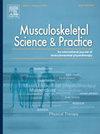神经动力学测试对上肢压迫性神经病的诊断准确性:一项系统回顾和荟萃分析
IF 2.2
3区 医学
Q1 REHABILITATION
引用次数: 0
摘要
下肢神经动力学测试通常用于诊断该区域的神经病变,包括颈神经根病和腕管综合征,尽管其诊断准确性在不同的条件和标准下仍不确定。目的探讨上肢神经动力学检查对上肢卡压性神经病的诊断准确性及其变化和诊断标准。方法在不同的数据库(于2025年2月建立)中进行系统回顾和荟萃分析,包括评估这些测试诊断准确性的研究。灵敏度、特异性、似然比(LR)、诊断优势比、诊断准确性和曲线下面积(AUC)采用双因素和单因素荟萃分析计算。使用GRADE方法评估证据质量,并进行meta回归以检查诊断标准的影响。结果共纳入12项研究。神经性疼痛的似然比为LR+:1.65和LR-:0.57,颈椎病的似然比为LR+:2和LR-:0.47,腕管综合征的似然比为LR+:1.45和LR-:0.66。上肢神经动力学试验2A对颈神经根病的诊断准确率最高(AUC: 0.76),其中LR+:2.59, LR-:0.42,而试验3的特异性最高(0.92;LR - LR +: 7日:0.48)。腕管综合征的诊断准确率较低(AUC: 0.62)。元回归显示显著的诊断标准相互作用,有利于结构分化操作(p = 0.002)。结论上肢神经动力学测试对上肢卡压性神经病的诊断敏感性中等,特异性低至中等,诊断准确性在不同条件下存在差异。证据的确定性范围从极低到中等,强调需要谨慎的临床解释。诊断参考标准显著影响测试性能。本文章由计算机程序翻译,如有差异,请以英文原文为准。
Diagnostic accuracy of neurodynamic tests in upper-limb entrapment neuropathies: A systematic review and meta-analysis
Background
Upper-limb neurodynamic tests are commonly used to diagnose neuropathies in this area, including cervical radiculopathy and carpal tunnel syndrome, although their diagnostic accuracy remains uncertain across different conditions and criteria.
Objective
To assess the diagnostic accuracy of upper-limb neurodynamic tests and their variations and criteria for upper-limb entrapment neuropathies.
Methods
A systematic review with meta-analysis was conducted in different databases (for their inception in February 2025), including studies evaluating the diagnostic accuracy of these tests. Sensitivity, specificity, likelihood ratios (LR), diagnostic odds ratios, diagnostic accuracy and the area under the curve (AUC) were calculated using a bivariate and univariate meta-analysis. The quality of evidence was evaluated using the GRADE approach, and meta-regression was performed to examine the influence of diagnostic criteria.
Results
Twelve studies were included. Likelihood ratios for neuropathic pain conditions were LR+:1.65 and LR-:0.57, for cervical radiculopathy were LR+:2 and LR-:0.47, and for carpal tunnel syndrome were LR+:1.45 and LR-:0.66. The upper-limb neurodynamic test 2A showed the highest diagnostic accuracy (AUC: 0.76), with LR+:2.59 and LR-:0.42 for cervical radiculopathy, while test 3 had the highest specificity (0.92; LR+:7, LR-:0.48). Diagnostic accuracy for carpal tunnel syndrome was lower (AUC: 0.62). Meta-regression showed significant diagnostic criteria interaction, favoring structural differentiation maneuvers (p = 0.002).
Conclusion
Upper-limb neurodynamic tests show moderate sensitivity and low to moderate specificity for diagnosing upper-limb entrapment neuropathies, with diagnostic accuracy varying across conditions. The certainty of evidence ranges from very low to moderate, emphasizing the need for cautious clinical interpretation. Diagnostic reference criteria significantly influence test performance.
求助全文
通过发布文献求助,成功后即可免费获取论文全文。
去求助
来源期刊

Musculoskeletal Science and Practice
Health Professions-Physical Therapy, Sports Therapy and Rehabilitation
CiteScore
4.10
自引率
8.70%
发文量
152
审稿时长
48 days
期刊介绍:
Musculoskeletal Science & Practice, international journal of musculoskeletal physiotherapy, is a peer-reviewed international journal (previously Manual Therapy), publishing high quality original research, review and Masterclass articles that contribute to improving the clinical understanding of appropriate care processes for musculoskeletal disorders. The journal publishes articles that influence or add to the body of evidence on diagnostic and therapeutic processes, patient centered care, guidelines for musculoskeletal therapeutics and theoretical models that support developments in assessment, diagnosis, clinical reasoning and interventions.
 求助内容:
求助内容: 应助结果提醒方式:
应助结果提醒方式:


